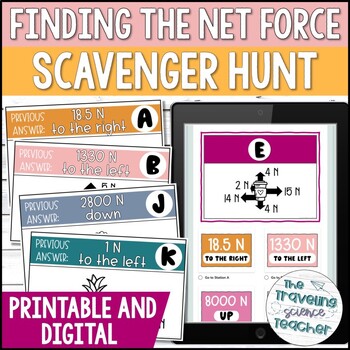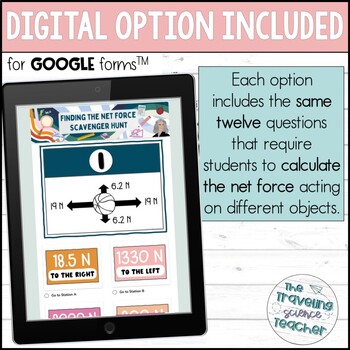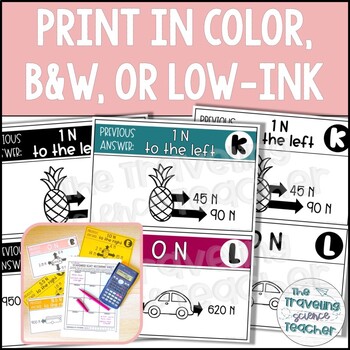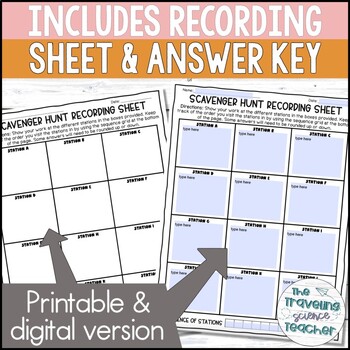Calculating Net Force Scavenger Hunt Activity | Balanced and Unbalanced Forces
- Zip
- Google Apps™

What educators are saying
Also included in
- Engage your students with this selection of fun and no- to low-prep activities on resultant forces that have them practice calculating the net force and identifying its direction from examples of balanced and unbalanced force pairs. This bundle contains two resources: an active, printable around-thePrice $4.80Original Price $6.00Save $1.20
Description
Are you looking for a fun activity that allows your students to practice calculating the net force acting on objects experiencing balanced and unbalanced forces? This printable and digital scavenger hunt is an engaging and student-led, low-prep task that helps your students review finding the net force of by considering all forces acting on an object. There are twelve questions on printable station cards included (three printing options). A digital version for Google Forms™ is also provided.
✨What’s Included✨
- 12 printable scavenger hunt station cards in 3 color options (color, B&W, low-ink)
- Access file for digital version of scavenger hunt (for Google Forms™)
- Printable and digital recording sheet to help your studens keep track
- Answer Key
Standards:
Supplemental Activity for NGSS MS-PS2-2: Force and Motion, TEKS 6.8B and TEKS 8.6A
Printable Version
Simply print the station cards and distribute them around the room. To prevent students from following others around the loop, I usually print 4 to 5 sets on different colored paper and have smaller groups of students follow a ‘color loop’, e.g. the green or blue station cards. The cards are designed so that students can begin at any of the station. They answer the question on their card, then look around until they spot the answer on the top bar of one of the remaining cards. This will become their next question card. Once they have answered all twelve questions correctly, they will find themselves back at their first station.
Google Forms™ version
Once you copied the Google Form™, you can it assign via the usual platforms (e.g. Google Classroom) to your students. They will be prompted to find the answer to the question on station card A, then select the answer card showing the correct answer and click ‘next’ at the bottom of the form. This will take them to their next station card. They will need to keep track of the order of station cards as they will need to enter this sequence to complete the task.
******************************************************************************************
How to use this resource:
⭐ Assessment of prior learning
⭐ Early finishers
⭐ Science Centers
⭐ Formative assessment of (newly learned) information
⭐ Homework
⭐ Mid- or end-of-unit review / Test Prep
You might also be interested in:
⭐ Net Force Calculation Activities BUNDLE
⭐ Net Force Calculation Digital Escape Room Activity
⭐ Net Force Calculation Scavenger Hunt Digital and Printable Halloween Activity
⭐ Newton's Second Law (F=ma) Scavenger Hunt Digital and Printable Activity
⭐ Forces and Motion Scavenger Hunt Digital and Printable Activity






